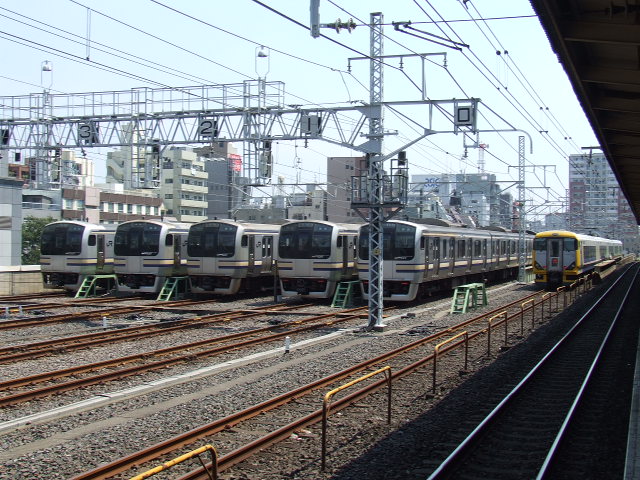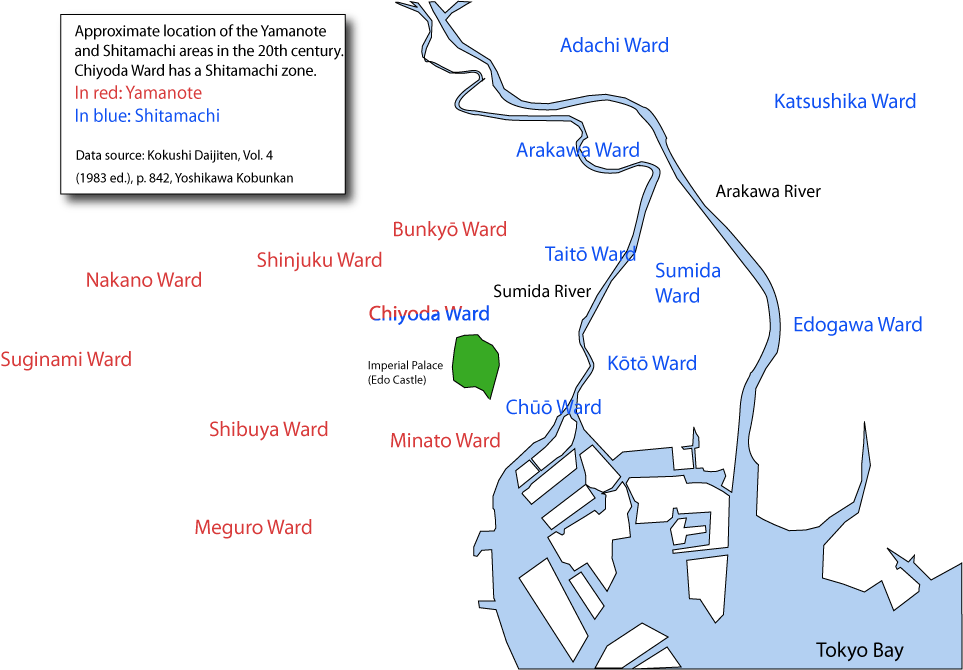|
Morishita Station (Tokyo)
is a subway station in Kōtō, Tokyo, Japan, operated by Toei Subway. Its station numbers are S-11 (Shinjuku Line) and E-13 (Ōedo Line). Lines Morishita Station is served by the following two lines. * Toei Shinjuku Line * Toei Ōedo Line Platforms Morishita Station consists of two island platforms (one for each line), each served by two tracks. File:Toei-subway-S11-Morishita-station-platform-20190831-165851.jpg, Shinjuku Line platforms File:Toei-subway-E13-Morishita-station-platform-20191201-114012.jpg, Oedo Line platforms History The station opened on December 21, 1978; service on the Ōedo Line began on December 12, 2000. Surrounding area The station is located underneath the intersection of Tokyo Metropolitan Routes 50 (Shin-Ōhashi-dōri) and 463 (Kiyosumi-dōri). The area is typically '' shitamachi'', with a mix of mid-rise office buildings, apartment buildings, and homes. Being close to Ryōgoku, many '' sumōbeya'' are located in the vicinity. Connecting bus s ... [...More Info...] [...Related Items...] OR: [Wikipedia] [Google] [Baidu] |
Ryōgoku
is a district in Sumida, Tokyo. It is surrounded by various districts in Sumida, Chūō, and Taitō wards: Yokoami, Midori, Chitose, Higashi Nihonbashi, and Yanagibashi. In 1659, the Ryōgoku Bridge was built, spanning the Sumida River just upstream of its confluence with the Kanda River. Its name, meaning "two provinces," came from its joining Edo (the forerunner of Tokyo in Musashi Province) and Shimōsa Province. The district derived its name from that of the bridge. The Forty-seven rōnin avenged the death of their lord, Asano Naganori, by breaking into the mansion of his enemy, Kira Yoshinaka, in 1703. Part of the mansion has been preserved in a public park in Ryōgoku. Ryōgoku Station in the neighboring Yokoami district was opened in 1904, bringing rail transportation to the area. It is regarded as the heartland of professional sumo. Most training stables or ''heya'' are based there. The first Ryōgoku Kokugikan stadium for sumo was completed in 1909. The present o ... [...More Info...] [...Related Items...] OR: [Wikipedia] [Google] [Baidu] |
Shinozaki Station
is a railway station in Edogawa, Tokyo, Japan. Its station number is S-20. The station is the easternmost station in Tokyo. The station opened on 14 September 1986. History * September 14, 1986 - The station opened. * March 19, 1989 - The station be an intermediate station. * May 20, 2008 - West gate (Twin Place side) opened. * May 19, 2018 - Started to use platform screen doors. Platforms Shinozaki Station consists of a single island platform served by two tracks. File:Toei-subway-S20-Shinozaki-station-platform-20190831-155303.jpg, Platforms Surrounding area The station is located underground just north of National Route 14 ( Keiyō Road) and the Shuto Expressway's No. 7 Komatsugawa Line. Commercial and shopping facilities are clustered around the station, but the remainder is primarily residential. The Edogawa River is approximately 1 kilometer northeast. Other points of interest include: * Edogawa Grounds * Tokyo Metropolitan Shinozaki High School * Edogawa Municip ... [...More Info...] [...Related Items...] OR: [Wikipedia] [Google] [Baidu] |
Kinshichō Station
is a railway station in Sumida, Tokyo, Japan, operated by East Japan Railway Company (JR East) and Tokyo Metro. The surrounding area is the largest shopping district in Sumida Ward, featuring several large department stores, numerous small shops and restaurants. Lines Kinshichō Station is served by the JR East Sōbu Line (Rapid) and Chūō-Sōbu Line, as well as the Tokyo Metro Hanzōmon Line (Station number Z-13). Station layout JR East platforms Tokyo Metro platforms History The station first opened on 9 December 1894. The Hanzōmon Line station opened on 19 March 2003. The station facilities of the Hanzōmon Line were inherited by Tokyo Metro after the privatization of the Teito Rapid Transit Authority (TRTA) in 2004. Passenger statistics In fiscal 2013, the JR East station was used by 103,522 passengers daily (boarding passengers only), making it the 36th-busiest station operated by JR East. In fiscal 2013, the Tokyo Metro station was used by an average of ... [...More Info...] [...Related Items...] OR: [Wikipedia] [Google] [Baidu] |
Miraikan
The , simply known as the , is a museum created by Japan's Science and Technology Agency. It was opened in 2001. It is situated in a purpose-built building in the Odaiba District of Tokyo. It can be reached by the Yurikamome driverless fully automated transit system from downtown Tokyo in about 15 minutes. Exhibits Highlights include real-time displays of data from a huge array of seismometers across Japan which shows the country gently vibrating. The occasional earthquakes for which Japan is noted show up as larger movements. Visitors can search the on-line database of recent earthquake activity. A section of rock core taken across the Cretaceous–Paleogene boundary (K–T boundary) records a major meteorite impact event that is believed to have led to the final demise of the dinosaurs. Asimo, the Honda robot is one of the star attractions along with the model maglev train. Geo-Cosmos The prominent Geo-Cosmos high resolution globe displays near real-time events of global we ... [...More Info...] [...Related Items...] OR: [Wikipedia] [Google] [Baidu] |
Kameido Station
is a railway station in Kōtō, Tokyo, Japan, operated by East Japan Railway Company (JR East) and the private railway operator Tobu Railway. Lines Kameido Station is served by the JR East Chūō-Sōbu Line and the 3.4 km Tobu Kameido Line The is a railway line operated by Japanese private railway company Tobu Railway in Tokyo. The line is in central Tokyo, a short 3.4 km branch off the Tobu Skytree Line at , southbound to with connections to the JR East Chūō-Sōbu Line. ... from . Station layout JR East platforms Tobu platforms This station consists of an island platform serving two tracks. History The JR station (originally on the Sōbu Railway) opened on December 1, 1894. The Tobu Kameido Line station opened on April 5, 1904. Surrounding area * Kameido Tenjinja Shrine * Yomiuri College of Car Mechanics References External links JR East station information {{coord, 35.6977, N, 139.8264, E, type:railwaystation_region:JP, display=title Rail ... [...More Info...] [...Related Items...] OR: [Wikipedia] [Google] [Baidu] |
Heya (sumo)
In sumo wrestling, a is an organization of sumo wrestlers where they train and live. It can also be termed ''sumo-beya''. All wrestlers in professional sumo must belong to one. There are currently 43 ''heya'' (as of 2022), each of which belongs to one of five ''Glossary of sumo terms#ichimon, ichimon'' (groupings of ''heya''). They vary in size, with the largest ''heya'' having over thirty wrestlers and smallest just one wrestler. Most ''heya'' are based in and around the Ryōgoku district of Tokyo, sumo's traditional heartland, although the high price of land has led to some newer ''heya'' being built in other parts of Tokyo or its suburbs. Most ''heya'' have a network of scouts, who may be former wrestlers themselves, friends of the head coach, or supporters of the ''heya'', who keep a look out for any powerful or athletic young men and follow the results of local sumo (and judo) competitions. Most new recruits join at the age of 15 or 16, straight from junior high school. ... [...More Info...] [...Related Items...] OR: [Wikipedia] [Google] [Baidu] |
Shitamachi
and are traditional names for two areas of Tokyo, Japan. Yamanote refers to the affluent, upper-class areas of Tokyo west of the Imperial Palace.Iwanami Japanese dictionary, 6th Edition (2008), DVD version While citizens once considered it as consisting of Hongo, Kōjimachi, Koishikawa, Ushigome, Yotsuya, Akasaka, Aoyama and Azabu in the Bunkyō, Chiyoda (in part), Shinjuku, and Minato wards, its size has grown to include the Nakano, Suginami and Meguro wards. Shitamachi is the traditional name for the area of Tokyo including today the Adachi, Arakawa, Chiyoda (in part), Chūō, Edogawa, Katsushika, Kōtō, Sumida, and Taitō wards, the physically low part of the city along and east of the Sumida River. The two regions have always been vaguely defined, as their identity was more based on culture and caste than on geography. While Tokugawa vassals of the warrior caste (hatamoto and gokenin) lived in the hilly Yamanote, lower castes (merchants and artisans) lived in ... [...More Info...] [...Related Items...] OR: [Wikipedia] [Google] [Baidu] |
Tokyo
Tokyo (; ja, 東京, , ), officially the Tokyo Metropolis ( ja, 東京都, label=none, ), is the capital and largest city of Japan. Formerly known as Edo, its metropolitan area () is the most populous in the world, with an estimated 37.468 million residents ; the city proper has a population of 13.99 million people. Located at the head of Tokyo Bay, the prefecture forms part of the Kantō region on the central coast of Honshu, Japan's largest island. Tokyo serves as Japan's economic center and is the seat of both the Japanese government and the Emperor of Japan. Originally a fishing village named Edo, the city became politically prominent in 1603, when it became the seat of the Tokugawa shogunate. By the mid-18th century, Edo was one of the most populous cities in the world with a population of over one million people. Following the Meiji Restoration of 1868, the imperial capital in Kyoto was moved to Edo, which was renamed "Tokyo" (). Tokyo was devastate ... [...More Info...] [...Related Items...] OR: [Wikipedia] [Google] [Baidu] |
Island Platform
An island platform (also center platform, centre platform) is a station layout arrangement where a single platform is positioned between two tracks within a railway station, tram stop or transitway interchange. Island platforms are popular on twin-track routes due to pragmatic and cost reasons. They are also useful within larger stations where local and express services for the same direction of travel can be provided from opposite sides of the same platform thereby simplifying transfers between the two tracks. An alternative arrangement is to position side platforms on either side of the tracks. The historical use of island platforms depends greatly upon the location. In the United Kingdom the use of island platforms is relatively common when the railway line is in a cutting or raised on an embankment, as this makes it easier to provide access to the platform without walking across the tracks. Advantages and tradeoffs Island platforms are necessary for any station with many th ... [...More Info...] [...Related Items...] OR: [Wikipedia] [Google] [Baidu] |





